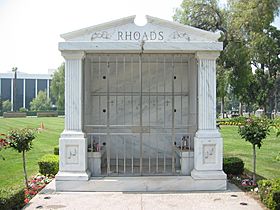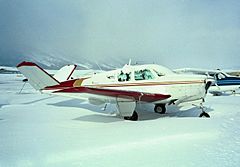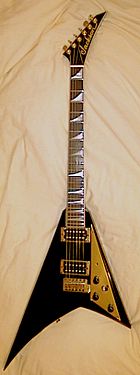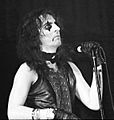Randy Rhoads facts for kids
Quick facts for kids
Randy Rhoads
|
|
|---|---|

Rhoads in 1980
|
|
| Background information | |
| Birth name | Randall William Rhoads |
| Born | December 6, 1956 Santa Monica, California, U.S. |
| Died | March 19, 1982 (aged 25) Leesburg, Florida, U.S. |
| Genres |
|
| Occupation(s) | Guitarist |
| Years active | 1972–1982 |
| Labels |
|
Randall William Rhoads (born December 6, 1956 – died March 19, 1982) was an American guitarist. He helped start the heavy metal band Quiet Riot. He was also the guitarist and a songwriter for Ozzy Osbourne's first two solo albums. These albums were Blizzard of Ozz (1980) and Diary of a Madman (1981). Randy Rhoads was added to the Rock and Roll Hall of Fame in 2021.
Randy learned to play classical guitar first. He mixed these skills with heavy metal music. This helped create a new style called neoclassical metal. With Quiet Riot, he used a black-and-white polka-dot look. This became a symbol for the band. He became very famous playing guitar for Ozzy Osbourne. He played on popular songs like "Crazy Train" and "Mr. Crowley". "Crazy Train" has one of the most famous heavy metal guitar riffs.
He died in a plane crash in Florida in 1982. He was on tour with Ozzy Osbourne. Even though his career was short, Randy Rhoads is very important in metal music. He created a fast and technical way of playing guitar solos. This style helped define metal music in the 1980s. He also made popular many guitar tricks used in heavy metal. These include two-handed tapping and tremolo bar dive bombs. The Jackson Rhoads model guitar was designed for him. Many lists of "Greatest Guitarists" include him. Other famous guitarists say he was a big influence on them.
Contents
Randy Rhoads' Early Life and Music Education
Randy Rhoads was born on December 6, 1956. He was born in Santa Monica, California. He was the youngest of three children. Both of his parents were music teachers. His brother, Kelle, was also a musician. In 1958, Randy's father left the family. Randy was only 17 months old. His mother, Delores, raised all three children. She had a music degree from UCLA. She also played piano professionally. She opened a music school called Musonia in North Hollywood. This helped her support the family.
The Rhoads family did not own a stereo. So, the children made their own music at home. Randy listened to the Beatles and the Rolling Stones when he was young. He would pretend to perform with his brother Kelle in their garage. Randy started folk and classical guitar lessons around age seven. He took them at his mother's music school. He then became interested in rock guitar. He started lessons from Scott Shelly at Musonia. Shelly soon told Randy's mother that he could no longer teach him. Randy's electric guitar skills were better than his own. Randy also took piano lessons from his mother. This helped him understand music theory.
Randy met his future bandmate Kelly Garni in middle school. They went to John Muir Middle School in Burbank, California. They became best friends. Kelly Garni said they were not popular. They often had problems at school. Randy taught Kelly how to play bass guitar. They formed a band together. They practiced at Rodney Bingenheimer's English Disco. This was a Hollywood nightclub in the 1970s. Randy learned to play lead guitar during this time. Kelly Garni said Randy was just starting to learn lead guitar when they met. Randy played at many backyard parties in Los Angeles in the mid-1970s.

Randy and Kelly later formed a cover band called Violet Fox. Randy's older brother Kelle played drums. Violet Fox played for about five months. They performed several times at Musonia. They played songs like "Mississippi Queen" by Mountain. They also played songs by the Rolling Stones, Alice Cooper, and David Bowie. After Violet Fox, Randy formed other short-lived bands. These included The Katzenjammer Kids and Mildred Pierce.
Kelly Garni said he and Randy often listened to Long Beach, California radio station KNAC. It was the only station that played music they liked. Through KNAC, Randy found much of the music that influenced him. They also spent time at a friend's house. This friend had a good stereo and many records. There, they listened to less common hard rock music. This included early Scorpions songs.
Live bootleg recordings were very popular then. Randy noticed how live versions of songs were different from studio ones. He saw the different guitar tricks guitarists used live. He started to learn these tricks and play them himself. Randy's brother said an Alice Cooper concert was very important for Randy. They went to it on July 11, 1971, in Long Beach. Kelly Garni agreed, calling Randy's discovery of Alice Cooper "a game changer." Guitarists Glen Buxton, Mick Ronson, and Leslie West influenced Randy's early playing.
Quiet Riot: Randy's First Band
When he was 16, Randy Rhoads and Kelly Garni started a band called Little Women. Around the same time, Randy began teaching guitar at his mother's school. He also played live shows at night. He finished high school early from Burbank High School. This special program let him graduate sooner. He could then teach guitar and focus on music full-time. They found a singer named Kevin DuBrow and a drummer named Drew Forsyth. The band soon changed its name to Quiet Riot.
Drew Forsyth had played with Randy and Kelly before. Kevin DuBrow was an L.A. photographer. He was not what Randy wanted for his new band. The other Quiet Riot members did not like him much. This caused a lot of problems in the band. Randy wanted a singer like Alice Cooper or David Bowie. But DuBrow kept trying to join. In the end, Randy and Kelly decided DuBrow shared their excitement. So, he was hired.
Quiet Riot quickly became very popular in Los Angeles clubs. By late 1976, they signed with CBS/Sony Records. Randy's "polka-dot theme" became a symbol for the band. Many fans started wearing polka-dot bow-ties and vests to shows. They copied what Randy wore on stage.
The band was very popular in Los Angeles. But their albums, Quiet Riot and Quiet Riot II, were only released in Japan. The relationship between DuBrow and Garni became very difficult. Because of this, Randy had to let his friend Garni go from the band.
Joining Ozzy Osbourne's Band
In 1979, Ozzy Osbourne, the former singer of Black Sabbath, was in Los Angeles. He was trying to start a new band. Dana Strum, a bassist Randy knew from L.A. clubs, kept calling Randy. He wanted Randy to audition. Randy first told his Quiet Riot bandmate Rudy Sarzo he was not interested. But he finally agreed to go just to get Strum to stop calling. Randy got the call for the audition right before his last Quiet Riot show in September 1979. The day before Ozzy was going back to England, Randy agreed to audition for him. This happened at a studio in Los Angeles.
After the audition, Randy, Ozzy, Strum, and drummer Frankie Banali played music together for a few days. Then Ozzy went back to England. Randy was disappointed that Quiet Riot could not get an American record deal. He talked to his mother about joining a band that was already famous. When she asked if he would take "an offer like this one," he said, "Of course!"
Back in England, Ozzy met former Rainbow bassist Bob Daisley. They got along well and decided to work together. Ozzy was not happy with the guitarist they were working with. He told Daisley about a talented young guitarist he met in Los Angeles, Randy Rhoads. The new band's managers wanted an all-British lineup. They did not want to hire an unknown American guitarist. But manager Don Arden finally agreed. Randy flew to England. But he had to return home a few days later. English customs at Heathrow Airport turned him away. He did not have the right work permit. A person from Jet Records was supposed to help. But they never arrived. Randy spent the night in a holding cell. The next day, he was handcuffed and put on a plane back to the United States. Ozzy then called to say sorry. They made plans for Randy to return to England with the correct papers. Randy flew to England on November 27, 1979. He met Ozzy and Daisley at the Jet Records' offices in London. The three traveled by train to Ozzy's home, Bullrush Cottage. This house also had a practice space. Randy lived here with Ozzy, his wife Thelma, and their two children during his first weeks in England.
Recording Blizzard of Ozz
After a short search, Lee Kerslake, a former drummer for Uriah Heep, joined the new band. The band was then called The Blizzard of Ozz. They went into the studio to record their first album. It was called Blizzard of Ozz. Randy's guitar playing changed. Ozzy and Daisley gave him a lot of freedom. His work with Quiet Riot had been called "dull." It did not use classical scales or complex arrangements. But with Randy's new classical-style guitar work, Blizzard of Ozz became an instant hit. It was especially popular with rock fans in the U.S.
They released two songs from the album: "Mr. Crowley" and "Crazy Train". "Mr. Crowley" is in the key of D-minor. "Crazy Train" is in F-sharp minor. Ozzy said later that Randy told him most heavy metal songs use an A to E chord structure. Randy suggested they try to change that. So, they made a rule that almost every song on an album would be in a different key. Steve Huey from AllMusic said "Crazy Train"'s main guitar riff was "a classic." He noted it used the full minor scale in a new way.
"Crazy Train" and "Mr. Crowley" were ranked high in Guitar World magazine's polls. "Crazy Train" was 9th and "Mr. Crowley" was 28th on the "100 Greatest Guitar Solos" list. "Crazy Train" was also 51st on Rolling Stone's "100 Greatest Guitar Songs of All Time" list.
Creating Diary of a Madman
After a tour in the UK, the band recorded another album. It was named Diary of a Madman. In December 1981, readers of Guitar Player magazine voted Randy "Best New Talent." Readers of the UK-based Sounds magazine voted him "Best Heavy Metal Guitarist." Around this time, Randy played a special Quiet Riot show. He reunited with Kevin DuBrow for one night. This was at the Whisky a Go Go in West Hollywood. It happened during a short trip home. Randy's manager, Sharon Arden, told him not to do that again.
Before their first U.S. tour, Lee Kerslake and Bob Daisley were suddenly fired. This was done by Sharon, the band's manager and Ozzy's future wife. For the U.S. tour, Tommy Aldridge, a drummer from Black Oak Arkansas, was hired. Rudy Sarzo, who was Randy's bandmate in Quiet Riot, became the bassist. Diary of a Madman was released in October 1981. Since Kerslake and Daisley were no longer in the band, Aldridge and Sarzo's names and photos appeared on the album cover. This caused problems later about who owned the rights to the music. Kerslake said Randy almost left Ozzy's band in late 1981. He was unhappy about Kerslake and Daisley being fired. Kerslake said Randy told them he would leave the band. But Kerslake told him not to be silly.
Around this time, Randy told Ozzy, his bandmates, and friend Kelly Garni that he was thinking of leaving rock music for a few years. He wanted to get a degree in classical guitar at UCLA. In a 1991 documentary film called Don't Blame Me, Ozzy confirmed Randy wanted this degree. Ozzy said he did not think Randy would have stayed in his band if he had lived. Kelly Garni thought that if Randy kept playing rock, he might have moved to keyboard-heavy rock. This style became popular in the 1980s. While on tour with Ozzy, Randy would find classical guitar teachers for lessons whenever he could.
When he died, Randy had already decided to leave Ozzy's band. He would leave after he finished his contract. Ozzy saw this as a betrayal. Their relationship became very difficult. Ozzy's challenging behavior soon convinced Randy to leave the band. He agreed to play on a live album. But he said he would leave after his contract with Jet Records was done. This included one more studio album and a tour. The planned live album was canceled when Randy suddenly died weeks later. But the idea was brought back with the release of Speak of the Devil in November of that year.
Randy Rhoads' Tragic Death
Randy Rhoads played his last show on Thursday, March 18, 1982. It was at the Knoxville Civic Coliseum. The next day, the band was going to a festival in Orlando, Florida. It was called Rock Super Bowl XIV.
After driving most of the night, they stopped. This was at Flying Baron Estates in Leesburg, Florida. They needed to fix the tour bus's broken air conditioning. Ozzy Osbourne was still asleep. On the property, owned by the tour bus company, there was an airstrip. It had helicopters and small planes. The tour bus driver, Andrew Aycock, was also a private pilot. Without asking, he took a small plane. It was a single-engine Beechcraft F35. On the first flight, Aycock took keyboardist Don Airey and tour manager Jake Duncan. Duncan later said Aycock flew very close to the bus. He wanted to wake up drummer Tommy Aldridge. They landed. Then, a second flight took off. Randy Rhoads and makeup artist Rachel Youngblood were on board. Randy was afraid of flying. But he wanted to take some aerial photos for his mother. He tried to get bassist Rudy Sarzo to join him. But Sarzo chose to get more sleep instead.
During the second flight, Aycock tried to fly close to the tour bus again. He made two close passes successfully. But he failed on the third try. Around 10 a.m., after being in the air for about five minutes, one of the plane's wings hit the top of the tour bus. The wing broke into two parts. The plane then spun out of control. It hit the top of a pine tree. Then it crashed into the garage of a nearby house. The plane burst into flames. Randy Rhoads, who was 25, died instantly. Aycock, 36, and Youngblood, 58, also died.
Randy Rhoads' Musical Gear
Guitars Randy Used
Just before leaving Quiet Riot in 1979, Randy drew pictures of a polka-dot Flying V-style guitar. He gave them to Karl Sandoval, a guitar maker in California. The guitar Sandoval built for Randy became one of his most famous instruments. Randy's guitars included:
- 1974 Gibson Les Paul Custom Alpine White
- 1957 Gibson Les Paul Black Beauty (used only for photos)
- Karl Sandoval "Polka Dot" V
- Jackson Rhoads White "Prototype" Concorde
- Jackson Black Rhoads with fixed bridge
- Fender Stratocaster
Guitar Strings
He liked .009 gauge strings for Blizzard of Ozz. He used .010 gauge strings for Diary of a Madman.
- GHS Boomers, .009–.042 (for Blizzard)
- GHS Boomers, .010–.046 (for Diary)
Guitar Pickups
Randy Rhoads' pickups included:
- Original pickups on his 1974 Gibson Les Paul Custom.
- DiMarzio Super Distortion/PAF Humbucker on Karl Sandoval's Flying V.
- Seymour Duncan Distortion/Jazz Model on his Jackson guitars.
Effects Pedals Randy Used
Randy said the "MXR Distortion Plus is the only gadget I use a lot." His effects pedals included:
- Dunlop Cry Baby Wah-wah
- Roland:
- RE-201 Space Echo
- Volume Foot Pedal
- Korg echo
- MXR:
- Distortion +
- 10 Band EQ
- Flanger
- Stereo Chorus
Amplifiers Randy Used
- 100 Watt Marshall model 1959 with KT88 Power Tubes
- Marshall 4×12 Cabinets with Altec 417C speakers
2019 Equipment Theft Incident
In December 2019, Ozzy Osbourne offered a $25,000 reward. This was for information to find several pieces of equipment. Most of it belonged to Randy Rhoads. It was stolen from Musonia music school on November 28, 2019.
Stolen items included Randy's first electric guitar, a 1963 Harmony Rocket. Also taken was a Peavey Amp Head from Quiet Riot's original stage gear. A very rare Randy Rhoads Series Marshall Head (Prototype No. 1 or 2) was also stolen. This was given to the Rhoads family by the Marshall Company. A Great Depression-era Silver French Besson trumpet, owned by his mother, was also taken. Many gifts from fans, souvenirs, all photos of Randy, and other instruments were also stolen. The items were found just a few days later in a dumpster.
Randy Rhoads' Lasting Influence
Randy Rhoads was ranked 36th on Rolling Stone Magazine's "100 Greatest Guitarists" list. He was also ranked fourth on Guitar World Magazine's "100 Greatest Heavy Metal Guitarists." He placed 26th in Guitar World's "50 Fastest Guitarists" list.
Randy's biggest guitar influences were Leslie West, Ritchie Blackmore, Michael Schenker, Gary Moore, Charlie Christian, and John Williams.
Since his death, Randy's music has greatly influenced genres like neoclassical metal. Many famous guitarists admire his work. These include Dimebag Darrell of Pantera, John Petrucci of Dream Theater, Zakk Wylde, Michael Romeo, Alexi Laiho, Mick Thomson of Slipknot, Paul Gilbert of Mr. Big, Buckethead, Michael Angelo Batio, Tom Morello of Rage Against the Machine, and Mike McCready of Pearl Jam.
Tommy Aldridge, who Randy thought was his favorite drummer, said working with Randy was "inspirational." He called it "life-changing." Musically, he said playing with Randy was the best part of his career. He felt Randy helped him play at a higher level.
Not everyone praised Randy's talent during his life. Fellow guitarist Eddie Van Halen was not very impressed in 1982. He said, "Everything he did he learned from me" and "I don't really think he did anything that I haven't done." But he also said, "He was good." J. D. Considine of Rolling Stone Magazine criticized his playing. In his review of Diary Of A Madman, he called Randy "a junior-league Eddie Van Halen." He said Randy had many skills but lacked imagination. Years later, however, the magazine listed Randy as one of the greatest guitarists of all time.
Awards and Honors After His Death
Just before Randy's death, Jackson Guitars created a special guitar model for him. It was called the Jackson Randy Rhoads. Randy had originally called his white pinstriped V guitar "the Concorde." Randy received one test version. It was a black offset V guitar with a fixed bridge. This is the basis for today's RR line of Jackson guitars. But Randy died before the guitar was made for sale.
Jackson Guitars released an exact copy of Randy's original white "shortwing" V. Jackson's guitar makers carefully studied Randy's original guitar. They took photos and measurements to make the most accurate copy possible. The guitar comes with black gaffer's tape on the top wing and back. This is just like Randy's guitar. Only 60 of these guitars were made. Each one had a special price of $12,619.56. This number is Randy's birthday. In 2010, Gibson Guitars announced a new custom guitar. It was modeled after Randy's 1974 Les Paul Custom.
To honor Randy, Marshall Amplification released the 1959RR at NAMM 2008. This amp is a special, all-white Marshall Super Lead 100-watt head. It is based on Randy's own Super Lead amp. Marshall engineers looked closely at Randy's actual amplifier. They made the 1959RR to match those exact details. This included a special high-gain change Randy asked for when he visited the Marshall factory in 1980.
In April 2011, author Joel McIver announced a new book. It was the first full story of Randy Rhoads' life. It was called Crazy Train: The High Life and Tragic Death of Randy Rhoads. Zakk Wylde wrote the introduction. Yngwie Malmsteen wrote the afterword. In June 2012, Velocity Publishing Group announced another full book about Randy. It was written by Steven Rosen and Andrew Klein. It had over 400 pages of information.
May 31, 2011, was the 30th anniversary of Blizzard of Ozz and Diary of a Madman. Both albums were re-released with improved sound. They were put back to their original state. Bob Daisley's bass and Lee Kerslake's drums were included. Blizzard had three extra songs: "You, Looking at Me, Looking at You," "Goodbye to Romance" (2010 Vocal & Guitar Mix), and "RR" (Randy Rhoads in-studio guitar solo). Diary was supposed to have longer versions of some songs. But they were not included in the re-issue. A special version of Diary of a Madman included a second CD called Ozzy Live. This was a live album with songs from the 1981 Blizzard of Ozz tour. This performance had the same musicians as the Tribute album. The special box set also included vinyl records of the original albums. It had a 100-page book and a DVD called Thirty Years After the Blizzard. This DVD included never-before-seen video of Randy.
Producer Kevin Churko mixed the 2010 Ozzy Live CD. He said that Epic Records has "a lot more in the vault" for future releases. These would be more of Randy's music with Ozzy. Many of the band's live shows from that time were recorded.
Randy's mother, Delores Rhoads, started the Randy Rhoads Scholarship Endowment. This is at California State University, Northridge. It gives yearly scholarships to guitar students. This is done to remember her son.
On January 18, 2017, Randy Rhoads was added to the Hall of Heavy Metal History. He was honored for defining heavy metal lead guitar.
Randy Rhoads was officially added to the Rock and Roll Hall of Fame on October 30, 2021. He received the Musical Excellence Award. Ozzy Osbourne spoke about him in a video message. Guitarists Tom Morello of Rage Against the Machine, Zakk Wylde, and Kirk Hammett of Metallica also spoke.
Randy Rhoads' Music Albums
With Quiet Riot
- Quiet Riot (1977)
- Quiet Riot II (1978)
- The Randy Rhoads Years (1993)
With Ozzy Osbourne
- Blizzard of Ozz (1980)
- Mr Crowley Live EP (1980)
- Diary of a Madman (1981)
- Tribute (1987)
- Ozzy Live (2011)
Images for kids
-
An Alice Cooper (pictured) concert was a "game changer" for Rhoads.
See also
 In Spanish: Randy Rhoads para niños
In Spanish: Randy Rhoads para niños














